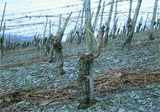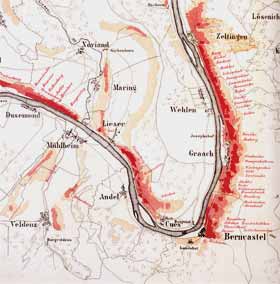
| Vineyard location Our Riesling grapes flourish on the steep slopes between Brauneberg and Zeltingen. |
Where our vineyards are to be found |
| Classification dating from 1868 This already shows the old classification of vineyard locations undertaken in 1868. It is based on the results of an evaluation of the vineyards along the Moselle, Saar and Ruwer carried out by the Prussian tax authorities between 1816 and 1823. |
This is, in fact, the oldest existing official classification of vineyard locations in the world. |
| The soil The various soil types have been formed over millions of years by physical and chemical weathering of rocks complemented by the addition of organic matter to form humus. |
 |
The action of wind, water, heat, cold and ice combine to mechanically break up the rock formations into stones and gravel. |
Large differences of temperature, friction and the expansion of freezing water in cracks in the rocks all play a vital role. |
| The Devonian (named after the county of Devon) was part of the Palaeozoic era lasting from about 580 to 220 Million years ago during which sedimentary rocks were deposited which ultimately, after undergoing metamorphosis caused by heat and pressure, became the slate which is the basis for much of the Moselle region. | Our Riesling grows in various vineyards situated on many variations of these rocks, which reflect light in colours ranging from blue via grey to bronze. |
| We cultivate our vines in a way that protects the environment. Our wine estate receives financial contributions under the scheme to promote the cultivation of wine in the steepest vineyards in an environment friendly and climate conserving manner. |
  ELER: here Europe is investing in rural areas |

